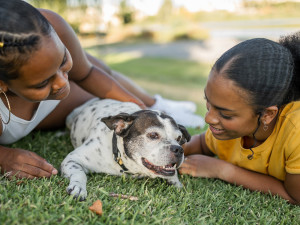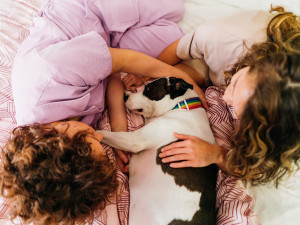Spending Time With Dogs Can Make You Better in Social Situations, Study Says
Especially if you pet them.

share article
Dogs are like Swiss army knives, with a thousand ways they can help us outopens in a new tab. We know that simply petting a pup can help lower our blood pressure, elevate our mood, and help us relax. It has recently been discovered that interacting with a dog has neurological benefits, too: It helps develop the part of the brain that regulates our emotions and social skills.
So, if you want to increase the activity in your prefrontal cortex (and who among us doesn’t?), you will be interested in an October 2022 studyopens in a new tab in which researchers found that hanging with a pup resulted in more activity firing in this region of the brain — specifically when the participants petted the dogs.
Why this is a big deal
It’s fair to ask why activity in the prefrontal cortex even matters. Well, that part of the brain is involved in emotional regulation and social interactions. In other words, the prefrontal cortex processes how we interact with other humans. This part of the brain is important for so much of what is necessary for emotional wellbeing and proper social functioning. We rely on the prefrontal cortex to help us be the fun people our friends actually want to spend time with. It helps us pick up on social cues, like body language — it even helps us know when to laugh at that joke our pal spent forever building up to.
Animal-assisted therapy and the use of therapy dogs may benefit people precisely because of these effects on the brain. Understanding the mechanism by which people benefit from contact with dogs can make it easier for such therapeutic work to be effective.
The connection between petting a dog and brain health
Participants in the study had six interactions over a two-week period — three with a real dog and three with a plush animal. The plush animal was a lion named Leo with a hot water bottle inside to give him the heat and weight of a real dog. Each session lasted 10 minutes and was divided into five two-minute segments.
The five segments were: no dog/plush animal present, watching the dog/plush animal from a meter away, the dog next to them on the couch or the plush animal on their thigh, the person petting the dog/plush animal, and finally the dog/plush animal out of sight again.
The people in the study did not have a sustained level of excitement in each interaction with a plush animal. But their brains got just as excited with each new interaction with a real dog. This will come as no surprise to those of us who see a dog and say, “Yay, a dog!” with the enthusiasm of someone finding water after being lost in the desert. Every. Single. Time.
Throughout the sessions, the person had electrodes on their head to measure brain activity by monitoring the levels of oxygenated and deoxygenated hemoglobin in the prefrontal cortex. (These allow an estimate of oxygen consumption, which is indicative of brain activity.) In the study, that part of people’s brains showed more activity when in the presence of a dog or a plush animal. The increase in activity was greater the more interactive the person was with the animal.
The effect of increased brain activity was more pronounced when petting rather than just touching a dog or a plush animal. When someone just saw a dog, their brain activity was less pronounced than when they touched or petted the live or plush animal, though all had some effect. After someone petted a real dog, the effect of increased activity in the brain lingered even when the dog was gone. That was not the case in the absence of the plush animal.
The future of dogs and mental-health treatment
The results of this study suggest that our social skills are overall improved when we interact with animals. But it also tells us that animal-assisted therapy may be especially helpful for people who struggle with motivation, attention, and socio-emotional functioning. If interaction with a dog increases emotional connection and involvement, therapies that include such interactions may also be able to help with learning and other therapeutic goals.
The results of this research may also improve opportunities for organizations involved in researching or implementing the use of dogs in therapy to advance the work and make it more effective. It may also make funding related studies easier, and that is such an important part of making progress, too.
Our brain knows that interacting with a real dog is good medicine. Just even further evidence that when dogs are around, we’re all the better for it.

Karen B. London, PhD, CAAB, CPDT-KA
Karen B. London, Ph.D., is a Certified Applied Animal Behaviorist and Certified Professional Dog Trainer who specializes in working with dogs with serious behavioral issues, including aggression, and has also trained other animals including cats, birds, snakes, and insects. She writes the animal column for the Arizona Daily Sun and is an Adjunct Professor in the Department of Biological Sciences at Northern Arizona University. She is the author of six books about training and behavior, including her most recent, Treat Everyone Like a Dog: How a Dog Trainer’s World View Can Improve Your Lifeopens in a new tab.
Related articles
![A woman holding a cat close to her while sitting on a yoga mat.]() opens in a new tab
opens in a new tabShockingly, Your Pet Will Enhance Your Mindfulness Practice
The next time they try to kiss your face while you’re in corpse pose, let them.
- opens in a new tab
Does Your Dog Have Therapy Dog Potential?
Renowned animal behaviorist Patricia McConnell, PhD, on what it takes to be a great therapy dog.
![Man hugging his fluffy white dog happily]() opens in a new tab
opens in a new tabChemistry Between People and Dogs Is Real (It’s Science)
How the “love hormone” oxytocin connects us with our pups.
![Valentin Pujadas illustration]() opens in a new tab
opens in a new tabFYI, Pets Are Incredibly Good For Your Mental Health
This Mental Health Awareness Month, experts share the science-backed ways our pets offer us emotional support.
![Boy reading a book on the sofa to his dog]() opens in a new tab
opens in a new tabWhat Happens When Kids Read Books With Dogs
Spoiler alert: it’s more than just cute.







